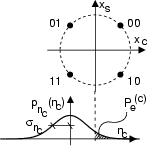




Avanti: Prestazioni L-PSK
Su: Modulazione di fase
Indietro: QPSK ed L-PSK
Indice
Indice analitico
In questo caso (PSK con 4 livelli) il demodulatore è costituito da due rami
indipendenti in fase e quadratura, operanti a frequenza di simbolo fL
metà di quella binaria.
0.700000
Demodulatore QPSK
 = 0):
mentre la probabilità di errore in un bit della sequenza re-serializzata risulta11.13
= 0):
mentre la probabilità di errore in un bit della sequenza re-serializzata risulta11.13
in cui
P c
c e
P
e
P s
s sono le probabilità
che il bit ricevuto provenga dal ramo in fase o da quello in quadratura, e si
assume che
Pe
sono le probabilità
che il bit ricevuto provenga dal ramo in fase o da quello in quadratura, e si
assume che
Pe c
c . Pe
. Pe s
s
 Pe
Pe c
c e quindi trascurabile.
e quindi trascurabile.
Osserviamo quindi come il QPSK consenta di ottenere le stesse prestazioni
del BPSK, utilizzando solo metà banda:
B = fL =  (con
(con  = 0). Il risultato ha una giustificazione intuitiva: osserviamo
infatti che, dimezzando la banda, si dimezza anche la varianza del rumore gaussiano
in ingresso al demodulatore, e questo fatto compensa la riduzione di ampiezza
delle componenti analogiche di bassa frequenza ricevute nel caso QPSK.
= 0). Il risultato ha una giustificazione intuitiva: osserviamo
infatti che, dimezzando la banda, si dimezza anche la varianza del rumore gaussiano
in ingresso al demodulatore, e questo fatto compensa la riduzione di ampiezza
delle componenti analogiche di bassa frequenza ricevute nel caso QPSK.





Avanti: Prestazioni L-PSK
Su: Modulazione di fase
Indietro: QPSK ed L-PSK
Indice
Indice analitico
alef@infocom.uniroma1.it
2001-06-01




![]() (con
(con ![]() = 0). Il risultato ha una giustificazione intuitiva: osserviamo
infatti che, dimezzando la banda, si dimezza anche la varianza del rumore gaussiano
in ingresso al demodulatore, e questo fatto compensa la riduzione di ampiezza
delle componenti analogiche di bassa frequenza ricevute nel caso QPSK.
= 0). Il risultato ha una giustificazione intuitiva: osserviamo
infatti che, dimezzando la banda, si dimezza anche la varianza del rumore gaussiano
in ingresso al demodulatore, e questo fatto compensa la riduzione di ampiezza
delle componenti analogiche di bassa frequenza ricevute nel caso QPSK.